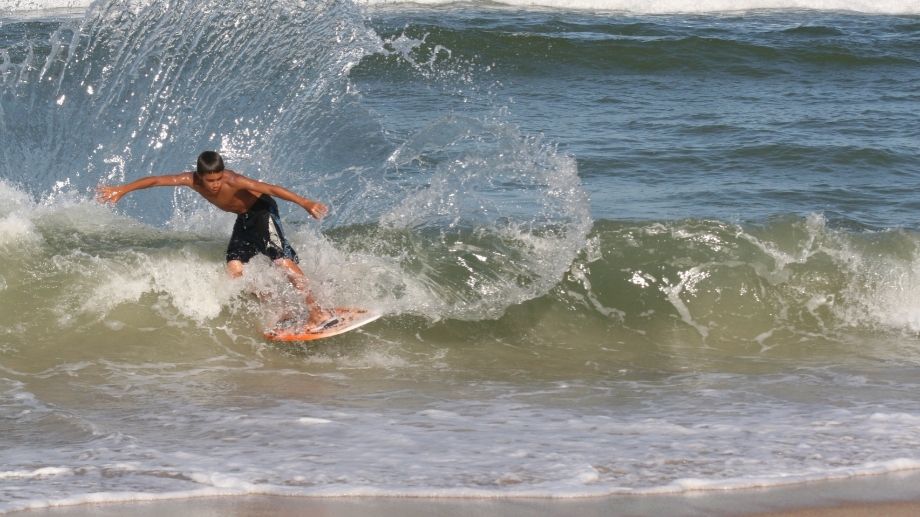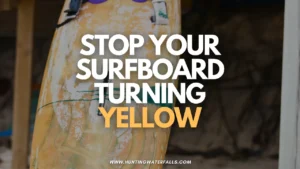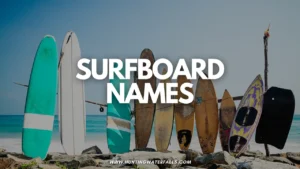Skimboarding may look easy enough, but it can be an extremely tricky sport to pick up. Learning how to skimboard is a lot of fun if you get the basics right.
If you fail to learn the basics then getting learning how to skimboard can be extremely difficult. But get these basics right and you'll be well on your way to skimming and even doing tricks in no time.
Choosing The Right Skimboard To Start With
I found this part of skimboarding really confusing. There are so many different board options out there and the price differences between them is significant. You also really want to get the right board to make skimming easier to learn.
Small wooden boards can start out as cheap as $20 with high-end foam boards selling for over $500-$600! Is it worth the investment and which board should you choose?
While I have written a full guide on the best skimboards for beginners if you want more indepth details on this topic and you can also read my guide on understanding skimboard shapes to get deep into the nitty gritty.
However, to get started the basics are really pretty simple and not too difficult to understand as a newbie.
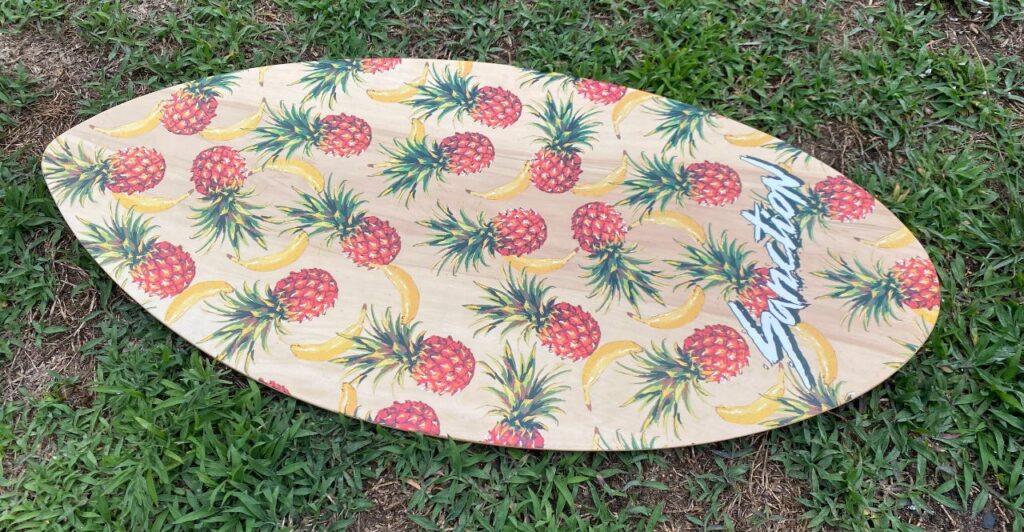
As a beginner these are some good rules to follow when buying a board:
- The bigger the better – The larger the board the more surface area it has to spread out your weight which means you'll skim further easier.
- The more buoyant the better – Foam skimboards (usually covered in fibreglass, epoxy or carbon fibre) float better than wooden skimboards and make skimming further and faster easier.
- The less flexible the better – A board that flexes looses a lot of energy and speed in the process. So a stiffer tougher board will travel further than a flexible board (and wood is pretty flexible) Read more on foam vs wooden skimboards
- The more expensive the better – Generally speaking with skimboards you really do get what you pay for. If you spend more you get a significantly better board
Stick Within Your Budget
As a beginner you're not going be aware of the differences and many people get into skimboarding and give up quickly. Plus a lot of people just want a skimboard to have a little bit of fun at the beach or lake when on holidays.
If you're not going to be serious about the sport you don't need to spend hundreds of dollars on a performance board and a wooden skimboard will get you started for cheap.
Then if you decide you really enjoy skimboarding an upgrade to a performance board will make sense and be well worth the investment.
The Best Cheap Board For Beginner Skimboarders
I tend to recommend people start with the Wavestorm Foam Skimboard (Amazon) as their first skimboard or just go with an affordable wooden skimboard (Amazon). You can read all about wooden skimboards if you want to start cheaply and are leaning towards this type of board.
The Wavestorm is foam and comes in larger sizes than wooden skimboards giving you better buoyancy as well as surface area to skim on. It's lacks the durability and rigidity of performance boards so it's not amazing for riding waves but it's cheap cost makes it a good entry board.
See the latest price of the Wavestorm Foam Skimboard at Amazon
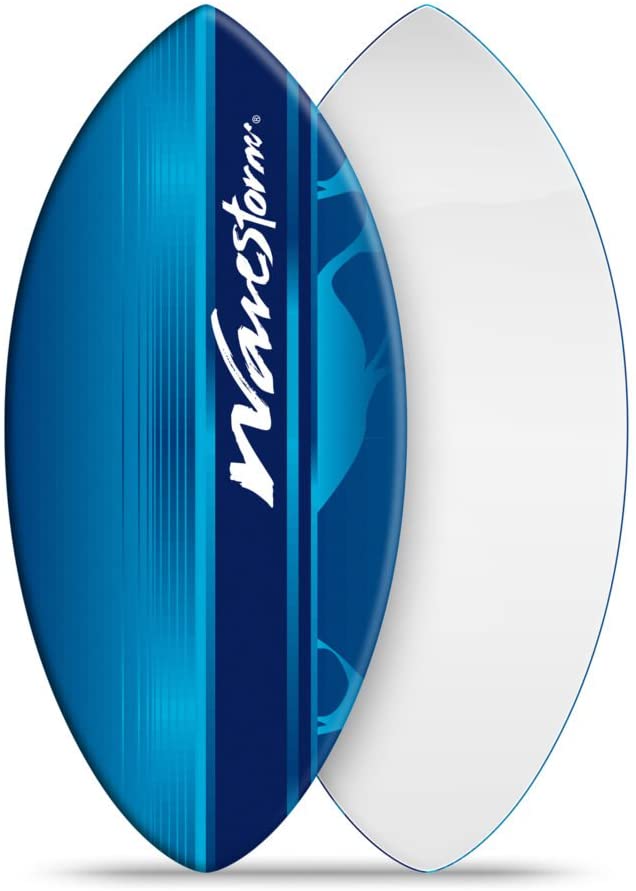
Best Performance Board For Beginner Skimboarders
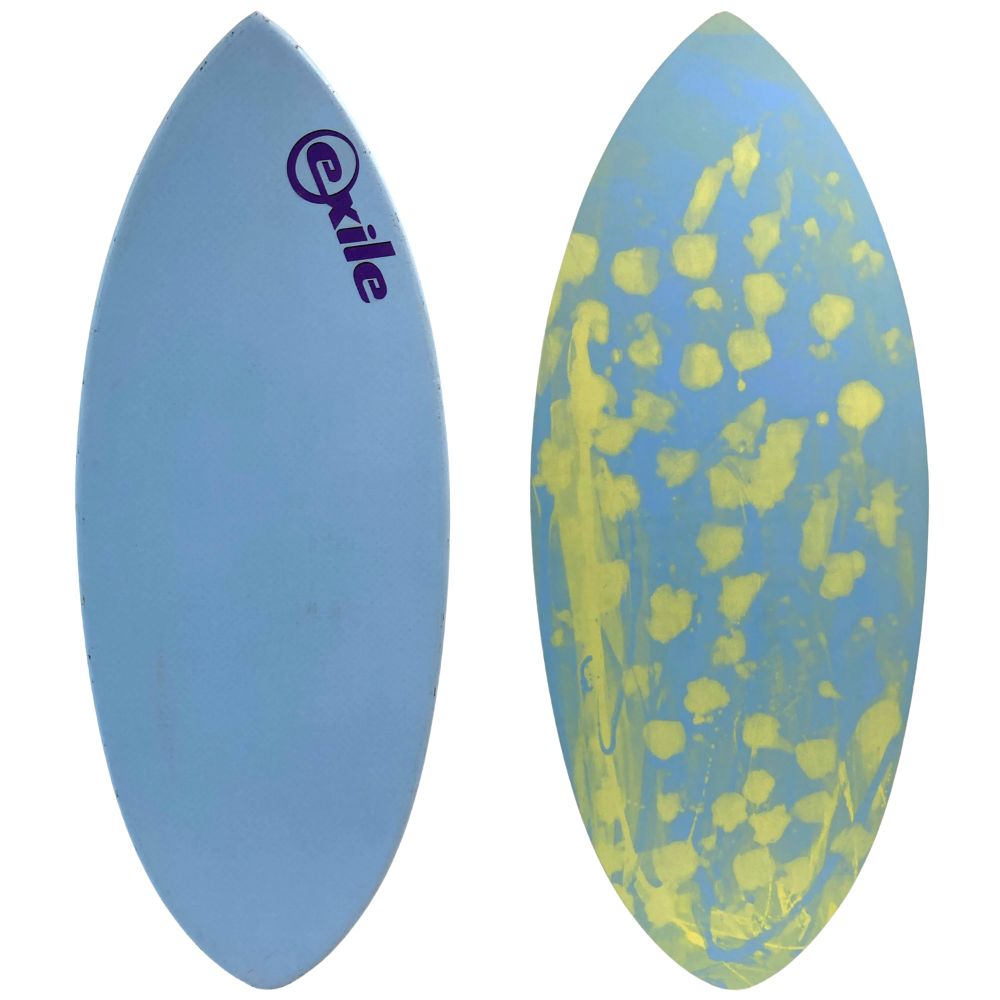
If your skill level is higher or you just want to jump straight up to a performance board then you can go straight to the top and get what the pros ride which is fiberglass boards or carbon fibre epoxy boards. For example, an Exile Carbon Fibre board (I recommend the Hybrid shape) is one of the best boards you can buy. This is an amazing board with all the features you need to both get started and ride waves like a pro once you get better.
If you want to save some money then the Exile EX0 Skimboard will save you a couple of hundred dollars but still give you the same shape as the carbon fibre board, but a bit less rigidity and flexibility.
Or something like the Driftsun Skimboard (Amazon) gives you a good quality board for an affordable price. Plus it comes with traction pads included (which usually cost around $50-$80 extra) making it even better value for money.
See the latest price of the Driftsun Skimboard at Amazon
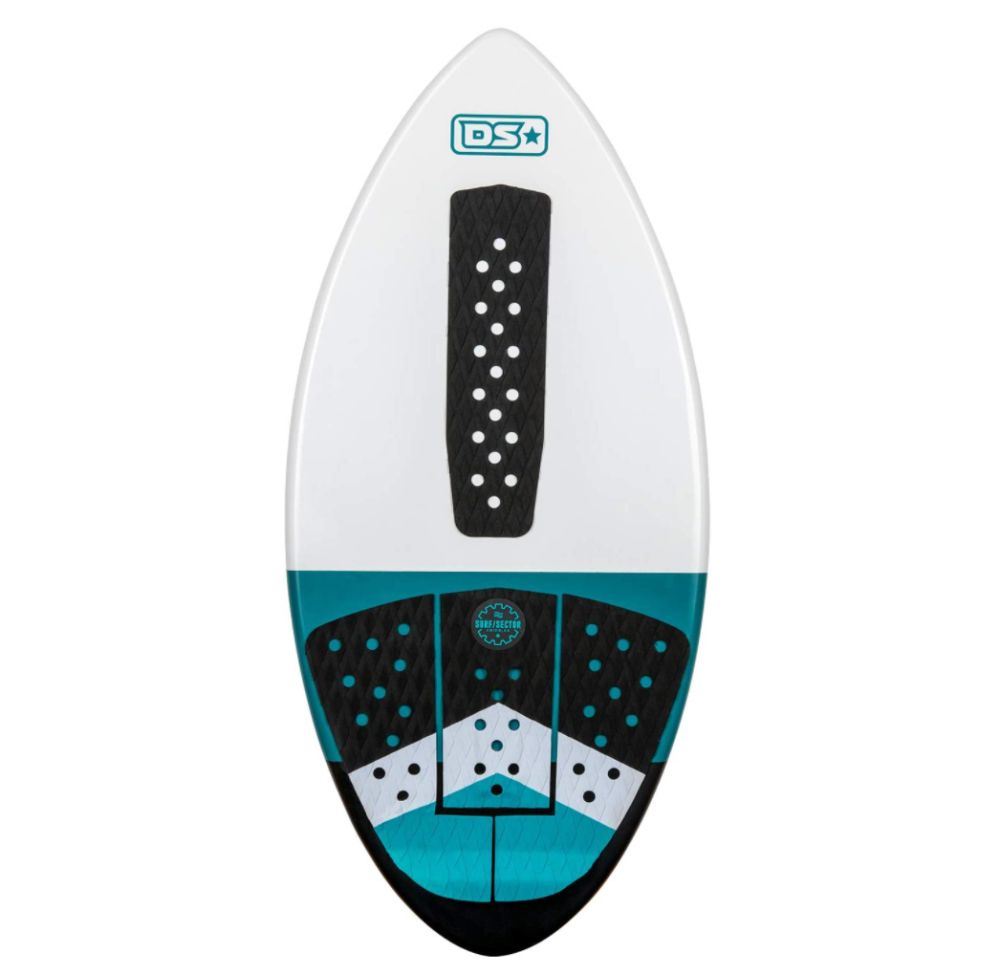
Waxing Your Skimboard (Or Using Traction Pads)
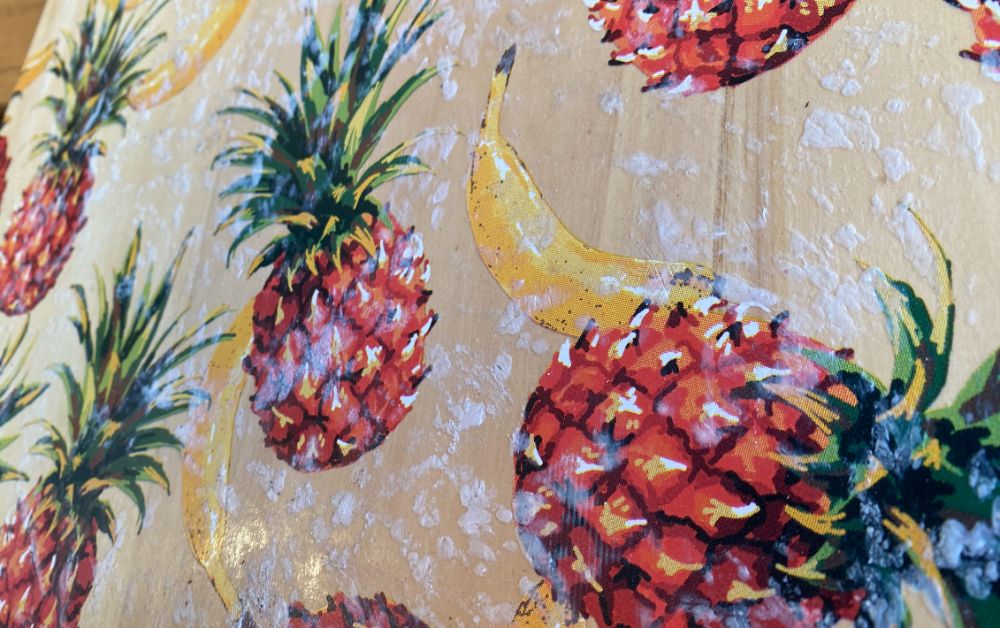
Once you purchase your skimboard it's IMPERATIVE that you add grip to the top of your skimboard otherwise you're going to slip off and injure yourself.
There are 2 ways of adding grip to the top of your skimboard. You can wax your skimboard or you can add traction pads. A lot of pro skimboarders will use traction pads but also wax the areas of their boards that the traction pads don't cover.
When it comes to skimboard traction pads vs wax ultimately it comes down to price. Traction pads are better as they help you with foot placement and give you better grip and control when you're on the board. However, traction pads can cost $50-$80 whereas a cake of wax will only set you back a couple of dollars.
It's not worth buying traction pads for a $20-$40 board as the pads will be worth more than the board. However, if you're spending hundreds of dollars on a board then yes, it's probably worth spending the extra money to get a back kicker pad as well as an arch bar.
But regardless of whether or not you get traction pads make sure you wax your skimboard.
The top of skimboards get EXTREMELY SLIPPERY when wet and if you try to jump on a wet skimboard whilst moving at high speeds you're asking for danger!
Wax provides grip for your feet which will stop you slipping off when you jump onto your board. I've done a full guide on exactly how to wax a skimboard properly but below are the key tips:
- Get surf wax (there's no “skimboard wax”) – You'll want to buy surf wax. There's no such thing as skimboard wax for the top of your board, regular surf wax works fine.
- Get the right temperature surf wax – Depending on the climate where you live and how warm the days are and the water is you'll want to get the right wax to suit you so it isn't too hard or doesn't melt. Below is a handy guide with links to relevant waxes on Amazon (affiliate links)
- Apply wax wherever your feet will go – For me that meant waxing the entire top of my board as I was a beginner and not great at feet placement. But if you're better at feet placement you can just put the wax where you know your feet will go. Check out my waxing a skimboard guide for exactly how to apply the wax.
| Wax Type | Water Temperature |
|---|---|
| Cold Water Wax | <60ºF (<15ºC) |
| Cool Water Wax | 58-66ºF (14-19ºC) |
| Warm Water Wax | 64-74ºF (17-24ºC) |
| Tropical Water Wax | >75ºF (>24ºC) |
Picking Your Spot To Start Skimboarding
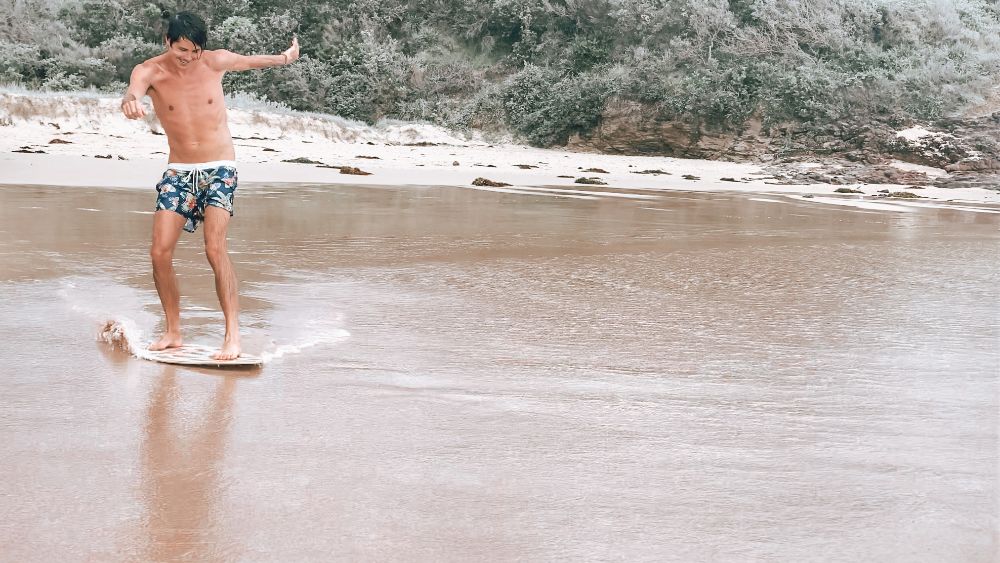
I still remember my first day skimboarding. It was in the middle of a storm, it was rainy and windy, the waves and water were extremely choppy and the beach was washed away and had an extremely steep decline down to the water.
Basically the worst place the try to learn how to skimboard. But you live and you learn and now you can learn from my mistakes.
When you're learning to skimboard you want to start in a calm flat location without much wind.
You'll want to have some wet sand you can skim on or some thin flat water. You don't want the water's surface to be too bumpy or choppy, the calmer the better when you're starting out
Ideally the water will be approximately 1cm or half an inch deep. You want a thin film of water on top of wet sand.
You can still skim on water that is deeper at around 2-3cm or 1 inch however once the water gets ankle deep this makes learning how to skimboard hard as you lose a lot of speed in the deep water.
I personally found that going to the beach at low tide was the ideal time to learn how to skimboard.
You'll also want to avoid windy days if you can as the wind can get under your board making it fly around everywhere and it can be difficult to stand on. If you are going on a windy day try to run with the wind not against it as I found that really helps.
So remember, try to find a spot with:
- Flat sand
- Wet sand
- Shallow water
- Low wind
How To Skim On A Skimboard: Step-By-Step Guide

Now that we have a skimboard and a place to practice let's look at exactly what you need to know to start skimming along the water.
Skimboarding may look like one fluid motion but it's made up of many different skills that you'll need to individually master in order to be able to skimboard properly.
You can just run and try to skimboard first go but I suggest taking a staged approach where you practice each individual part of skimboarding and build up. Don't worry we'll still get you skimming in your very first session.
The different skills we are going to talk about are:
- Foot placement
- Hand placement
- Dropping the board
- Running speed
- Run and jump technique
- One step drop (the most important technique)
- The monkey crawl
- Side slipping
- Tricks and wave riding
Foot Placement
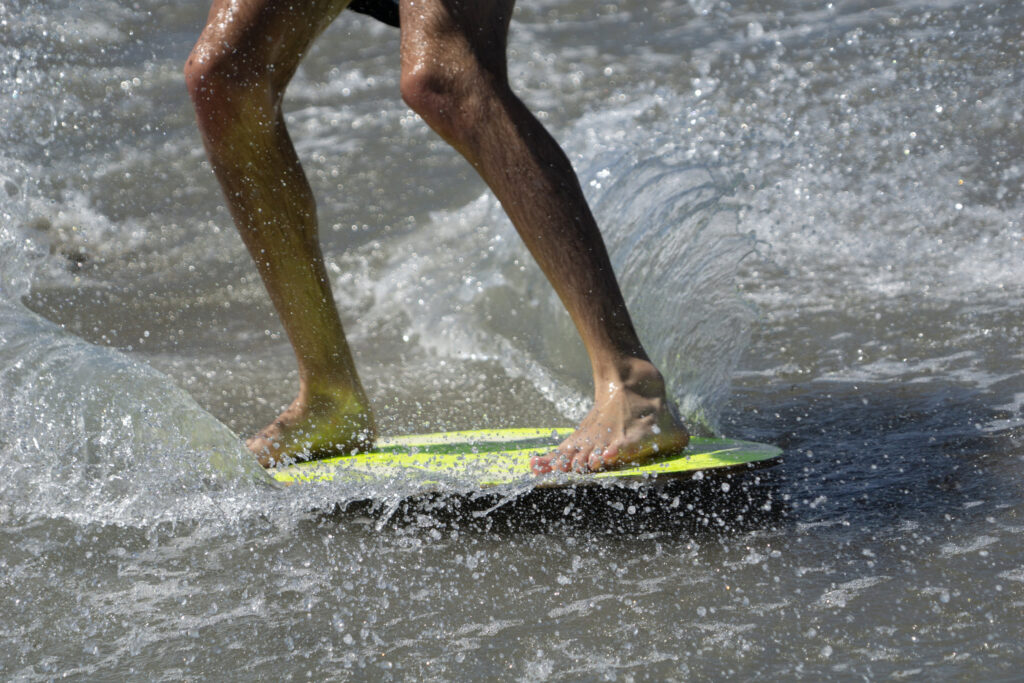
Skimboarding is literally running really fast and jumping onto a small moving object. The right foot placement will have you skimming out to waves, the wrong foot placement will have you flat on your face…and yes this has happened to me many times before.
To begin you'll want to start with the board on the sand (not it water). It can be on dry or wet sand, at this stage it doesn't matter but wet sand you'll slide a bit further. You can even practice this step at home on carpet or even outside on the grass.
The Correct Foot Placement When Skimboardoing
When jumping onto your skimboard you'll want to have your back foot pretty close towards the back of the board and your front foot slightly in front of the center of the board (but not right at the nose of the board).
Your feet should be approximately shoulder width apart and your feet should be positioned down the center line of the board. By this I mean you don't want your feet on either the right or left side of the board as this will either slow you down or cause your rail to dig in…again causing you to fall flat on your face.
How To Start Practicing Foot Placement When Skimboarding
To begin have your board stationary on the ground in front of you. Stand just behind your board.
Now practice jumping onto your board with 2 feet.
You'll want your back foot to land on the board first, followed quickly by your front foot.
When doing this you want to lean forward so your weight pushes you and the board forward. It's also much better to fall forwards than have the board slip out from under your feet and fall backwards.
Your board should slide forward a bit.
Practice this a few times until you begin to get a feel for the correct foot placement.
Hand Placement
When skimboarding you'll want to hold your board with one hand at the back in the middle and one hand on the side. This hand positioning allows you to throw your board forwards and to minimize potential rotations of the board as it falls to the ground.
Which hand goes at the back at the board will depend on your foot placement. Basically whichever foot is going at the back of the board when you land you'll want to place the corresponding hand at the back on the board
For a natural (right foot back, left foot forward) you'll want to place your right hand on the back of the board when running and left hand on the side.
For a goofy footer (left foot back, right foot forward) you'll want to place your left foot on the back of the board when running and the right hand on the side of the board.
The Most Important Technique To Learn In Skimboarding: The One Step Drop
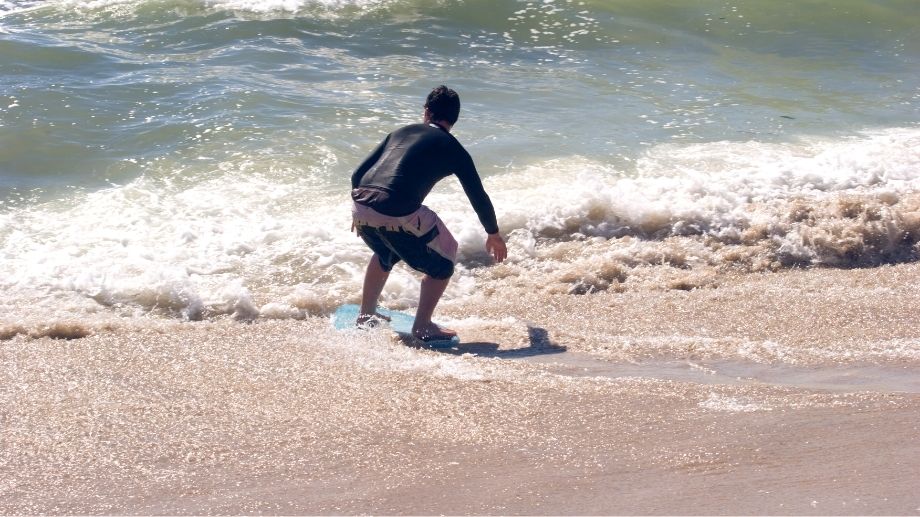
The best method for getting onto your skimboard quickly, easily, consistently and while maintaining speed is called the one step drop.
Other methods like throwing your board far out in front of you and running to catch up to it and then jumping on can work but you'll lose a lot of momentum, your board can go in all different directions sometimes and you'll just be working hard for each skim you do.
This sport involves a lot of sprinting and that'll tire you out easily. So the more energy you can save per skim the better.
The one step drop is simple to understand, easy to start doing and skimming quickly and difficult to master at super high speeds.
The idea here is that you run with your board and drop your board when you back foot touches the ground. You then take one step forward (thus the name “one step drop”) before hopping onto your board with your back foot first.
The method for the one step drop is this.
- Run with your board horizontal next to you
- At the same time your back foot hits the ground let go of your board – There is a slight push forward with you back hand but it is minor, you're mostly just dropping the board
- Take one step with your front foot
- Step your back foot onto the board – Remember to be leaning forward and having your weight over the center of the board not behind the board (which can cause you to fall back
- Place your front foot on the board – Remember to keep your knees bent
- Now you're skimming
The Best Videos For Learning The One Step Drop
Below are 2 of the best videos for learning the one step drop method. Both are taught by pro skimboarder Austin Keen
Start Stationary And Practice Dropping The Board
When practicing getting onto your board with the one step drop ideally you want to practice this technique stationary by dropping your board and then stepping onto it with your back foot first followed quickly by your front foot.
To drop the board you want to push the board forwards a little bit and let it fall horizontally to the ground.
Here you want to avoid throwing it with it's nose towards the ground as this will dig in and you won't be able to stand on it. You'll also want to avoid throwing it with the nose pointing upwards as this can catch the wind and also just makes landing harder.
To begin you can lean closer towards the ground to drop the board, but as you get better you should be able to drop the board from a standing or near standing position.
Alternatively: Throw Your Board In Front Of You And Run Onto It
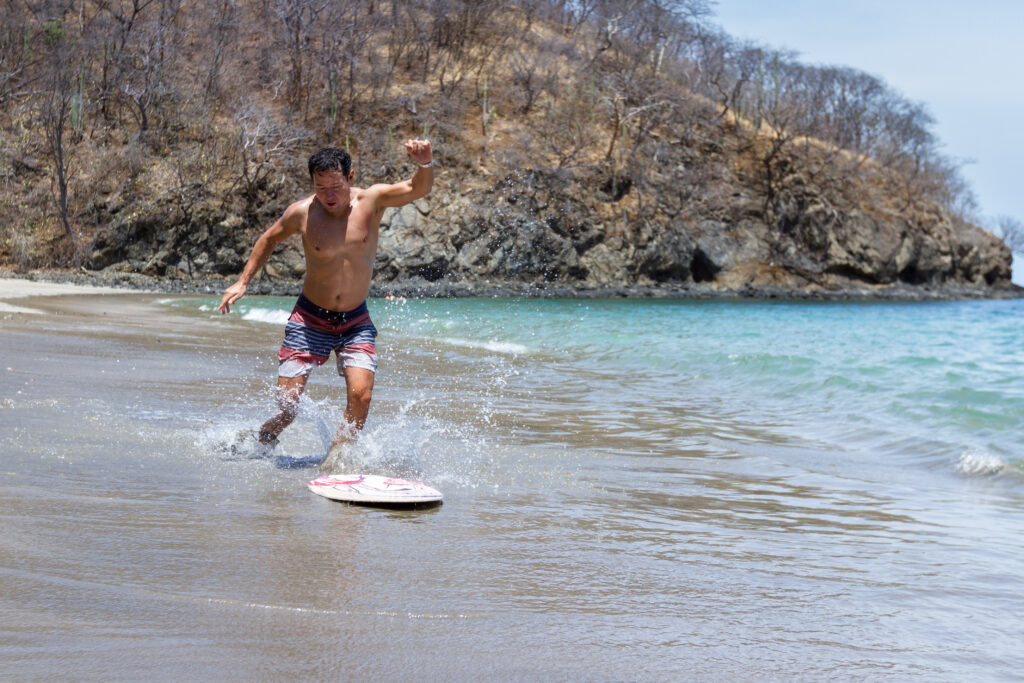
Another common method for getting onto your board and starting to skim is to throw your board out a little ways in front of you and then run and jump onto the board.
This can be a little more intuitive than the one step drop but it is also more difficult to do and you tend to lose a lot of momentum so it's not ideal.
Still, for kids or people not confident with the one step drop this can be a good alternative method.
The major downside of this is the board can go in many different directions and it can be hard to jump on sometimes. I've even had the board manage to hit my legs while doing this.
Also your feet need to adjust to the board location which often means a lot of little steps leading up to the board so you can jump on and just overall a lot of extra running which can cause your to get tired faster.
If you're learning to skimboard with a friend or teaching someone you can get them to hold the board on top of the water so it doesn't move and they can run and jump onto it.
You can also do the same with wet sand. Place the board down so it's stationary and practice running up to it and jumping on it.
Make Sure You Jump Onto Your Board From Behind
You want to make sure you run in a straight line behind your board jumping onto it from behind (not from the side).
Many people run up beside the board and then jump onto it and this will cause the board to move sideways, you'll lose a lot of forward momentum and also this can commonly cause the board to slip out from under your feet sending you flying backwards onto the ground.
So get behind the board, run faster than the board and jump forward onto it if you're going to use this method.
You want to land with your back foot on first like we discussed, quickly followed by your front foot. You also want to be bending forward slightly keeping your weight over the center of the board.
Running Speed (Start Slow)
Once you're comfortable dropping the board and jumping onto it from a stationary position you'll want to start adding in some movement.
Here my biggest advice is to start slow and slowly work up to higher speeds. Your first steps should be walking or jogging speed and work up to sprinting.
Ideally begin on wet sand or in very shallow water, however you can also try this on dry sand, carpet or grass if you want to practice at home.
Start off with a slow job and practice dropping the board and getting the correct feet placement and positioning your weight properly on the board.
As you feel more and more comfortable ramp up the speed over time.
Skimboarding In Deeper Water: The Monkey Crawl (or “Water Drop”)
Skimboarding in deeper water is more difficult and requires a different technique to skimboarding in shallow water.
However, if you're trying to skim out to waves then it's quite common to be starting in deeper water.
One of the best techniques for skimming in deeper water is called the monkey crawl method. This is a more advanced method for skimboarding and you'll want to have mastered the one step drop before doing this as the foot timing will be the same.
Really the only thing different with the monkey crawl vs the one step method is that you won't be dropping the board. Instead you'll be leaning forwards and placing your board into the water and then climbing onto the board while your hands are still on there.
With the monkey crawl you really lunge your weight forwards onto the board and onto your hands and then your feet follow through. For this reason you do actually need some decent upper body strength to be able to achieve this technique.
You'll also need an advanced pro board in order to perform the monkey crawl. This isn't really a technique you can do with a wooden board as they have too much flexibility and not enough buoyancy.
Once you've placed your feet you will remove your hands and skim like you usually would.
When you're doing the monkey crawl you'll want to do it into deeper water. You do not want to monkey crawl onto wet sand or into extremely shallow water as this is very difficult to do and the one step method is going to be better in these situations.
Side Slipping (or “Planing”)To Skim Farther
In order to skim farther out to waves you'll want to learn and master the slide slip. A lot of people do this naturally however you want to make sure you've got the right technique otherwise you're not going to get more distance and it's actually going to slow you down.
The side slip is a technique where you turn your board sideways as you're skimming so the side of your board is facing forwards as you slip out to the wave.
This reason is works is that if your board is facing forwards most of your weight is going to be on your back foot. This is going to cause the back of the board to drag in the water which will slow you down.
With the side slip your weight is moved evenly over both feet towards the center of the board leading to less drag and you maintaining more speed and getting a longer skim distance.
Below in the video on Monkey Crawling there are also some amazing tips on side slipping and how to do it properly. Side slipping tips start a 5m10s but I've set the video so if you hit play it should jump straight to that section of the video.
Key Tips When Side Slipping
- Always be engaged – You want to be in a stance with your legs bent and your core engaged so you can maintain maximum control
- Move your board sideways – The goal of the sideslip is to distribute your weight off the back of your board towards the middle. To do this move your board sideways.
- Slide your back foot up – It's really important to have your weight over the center of your board. Moving your back foot slightly towards the middle helps with weight distribution.
- Keep your weight over the center of your board – You want your center of mass to be right over the center of the board, not to one side or the other
- Not too heavy on the toes or heels – You want to engage your feet so you have equal weight on your toes and feet so the front does dig in (and nosedive) and the back doesn't drag. In choppy water you may need to have some weight on the back heels
- Look towards the wave – Focus your attention on where you are going. Look out towards the wave, not down at your feet
Avoid These Common Beginner Mistakes When Skimboarding
We've touched on the majority of these mistakes in our instructions on how to skimboard but I think it's important to highlight them here so you can be aware of the common mistakes and avoid them.
Starting In Deep Water Or Bad Conditions
When I started skimboarding I chose a beach with a steep decline with big swell, deep water and overall choppy conditions. This is a terrible way to begin learning how to skimboard.
Instead choose an area that is flat and easy to run on and has wet sand and/or very thin water.
Thinking Wooden Skimboards Are Good

It's harder to learn on a wooden skimboard. They are small, flexible and heavy…all things bad for a good board.
They are cheap which makes them a good starter board but just realize you'll never be able to do what the pros do on a wooden board. Understand it's limitations and upgrade as soon as you can.
Running Around The Side Of The Board and Jumping On
Jumping on the board from the side loses you momentum, pushes you in the wrong direction and makes it more likely the board will fall out from under you.
Instead make sure you are jumping on the board from the back or use the one step or monkey crawl methods we have taught you in this guide.
Having Your Weight On The Back of The Board
When you jump on the board with your back foot first it's natural to want to stand up straight. But this can often keep your weight over the back of the board which is bad.
It'll cause the board to slip out from under you and this led to some of my worst falls where I landed on my ass.
Starting Too Fast
You've seen the pros on instagram or TikTok and you want to do what they do. I get it, so did I.
However, starting at a full out sprint is a recipe for disaster and injury and it's one of the biggest dangers of skimboarding.
There are lots of little techniques to learn in skimboarding and the drop and getting onto your board is especially difficult. Do yourself a favor and start slow and work up to higher speeds as you get more proficient.
How To Do Skimboarding Tricks
Once you've got the running and getting onto the board down pat you'll likely want to begin doing some new tricks.
Tricks make skimboarding really fun and some of them can be learned fairly quickly, especially if you have any experience skateboarding.
Getting out to and riding waves is hard and advanced, but a lot of tricks can be done in shallow water and require no waves at all.
Spinning and Turning On Your Skimboard
One of the first tricks I learned and you should probably learn too is spinning and turning on your board.
Once you can skim straight begin practicing turning by leaning your weight onto one side on the board.
For me I found my frontside easier to turn in the beginning. So lean forward onto your toes and push the board into the water.
Here you'll also want to have your foot and weight more centered towards the back of the board as this makes turning easier.
For full spins that's a little different.
For spins bend your knees keeping your weight towards the center of your board. Drag our hand in the water to begin the spin then stand up to continue the spin.
Once you've mastered using your hands you can spin without your hands by using your shoulders to turn.
Shuv-It and Pop Shuv-It
The shuv-it is the next easiest trick to learn and the pop shuv-it is a little bit harder as it requires a jump as well so you may want to master the ollie first.
To shuv-it use your back foot to flick the board around as you jump and re-land on the board once it's done at 180º turn. You can also do full 360º turns before you land. This is called a backside shuv-it.
You can also do a frontside shuv-it by flicking the board with your front foot. This is a bit harder but still not too difficult. You can even practice these being stationary on carpet, grass or sand to get a feel for it before you take it to the water.
To pop shuv-it you want to put your foot right towards the back of the board and you are scooping it out of the water and jumping higher. You'll need deeper water in order to perform this otherwise your back foot and board will catch on the sand.
This is a fair big higher than the regular shuv-it so expect it to take a while to learn.
The Ollie
Ollie looks like one of the simplest tricks to do on a skimboard but it's actually quite a difficult trick to learn.
If you've had some experience skateboarding and ollie'ing on a skateboard you'll find doing an ollie on a skimboard fairly natural. However, if you've never ollied before just realize that this trick can take a lot of practice.
When doing an ollie on a skimboard you'll want to make sure you're in slightly deeper water as you'll be pushing the tail of your board down into the water to initiate the ollie.
You'll also have to be going fast in order to ollie. Somewhere between 80-100% sprinting speed is ideal.
Your back foot needs to be as far back as possible on your board with the ball of your foot centered on the board (as you'll be using this to push down on).
To ollie bend your knees over the board, the initiate a jumping motion straightening your knees and at the same time press down on the back of the board.
You skimboard is now rising up front side first so you'll want to bring your back foot up as you slide your front foot forward, slightly pushing down with your front foot, which will push the board level with your feet.
If you don't get this straight away or even in a few sessions don't worry. It can take A LOT of trial and error to be able to ollie on a skimboard.
How To Ride a Ramp On a Skimboard
Riding on a ramp can be a lot of fun and it looks really cool as well.
Make sure you start on smaller ramps and work your way up to bigger ones. Also make sure the ramp is wet before trying to skim on it so your board doesn't catch and stop leaving you to fall face first into the ramp.
Keep you knees really bent as you hit the ramp and ensure you have more weight on your back foot compared to your front foot.
When you hit the ramp you want to minimize friction on the ramp by doing a light jump to take some of your weight off the board and to send you riding over the ramp.
Catching Waves Skimboarding

The last and one of most difficult things you'll want to master when learning how to skimboard is how to actually catch waves skimboarding.
This is a whole other level of difficulty compared to just skimming and skimboarding waves is comparable to how difficult it is to catch unbroken waves on a surfboard. Maybe even more difficult given the types of waves you'll be catching and the timing skills you need to master.
In order to catch waves you'll need to have first mastered the one step drop and the monkey crawl and be able to skim at 80-100% sprinting speed.
You'll also need to learn:
- Timing the waves
- Turning onto the wave
- Riding the wave back to shore
Choosing Your Spot
When it comes to catching waves on your skimboard you may feel like any beach with close shore breaks will do. But actually the timing of the water coming up or drawing out as the wave breaks is vitally important to catching waves.
If it just doesn't match up it can be nearly impossible to catch waves, especially for less experienced skimboarders.
Ideally you want waves that break in sets. With the first wave pushing water up onto the sand and then having that water draw out as the second wave behind it breaks. This is going to be the breaking wave you're going to catch.
Also a beach that slants downwards like laguna beach uses gravity and the rush of the water to help you get out to waves. Whereas flatter beaches can sometimes be harder to reach and ride the waves.
There are two main times you want to skim out to catch a wave.
When The Water Is Rushing Up
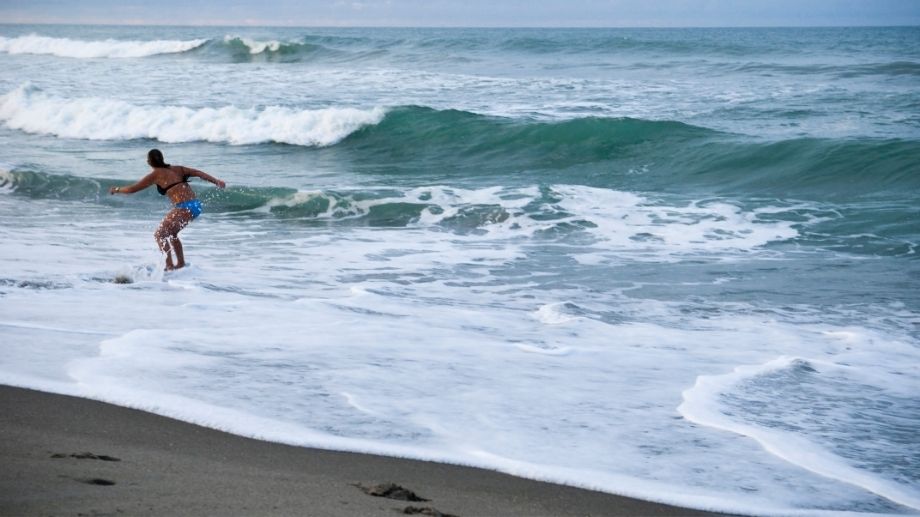
This is when the wave in front is pushing water up the beach. Here are you are going to do a water drop where you run into deeper water and jump onto you skimboard on top of this deeper water.
Here the monkey crawl is going to be an important technique
When The Water Is Rushing Out
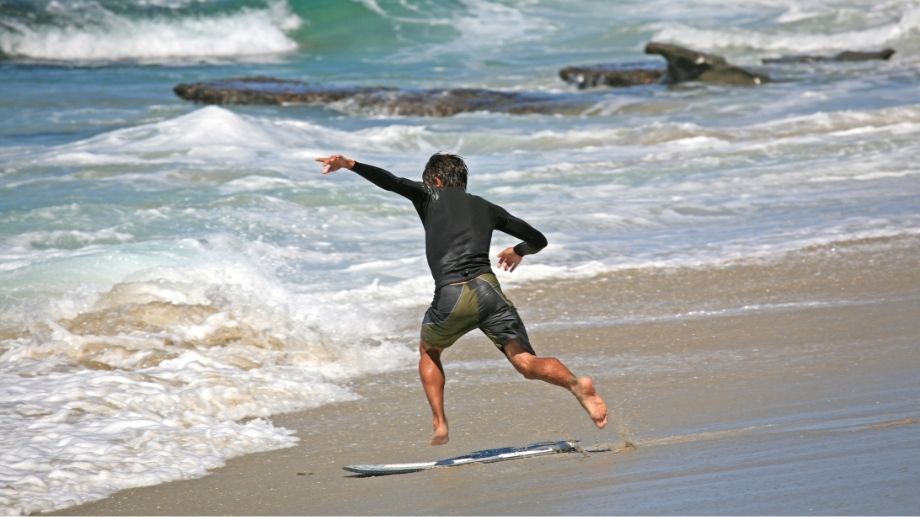
The second timing is when the first wave has pushed up onto the beach and the water is now rushing out as the second wave is coming in.
Here you can do the one step drop or monkey crawl depending on the depth of the water and you can really get some good speed out to the wave.
You can even start by sand skimming when the water is rushing out.
Timing The Wave
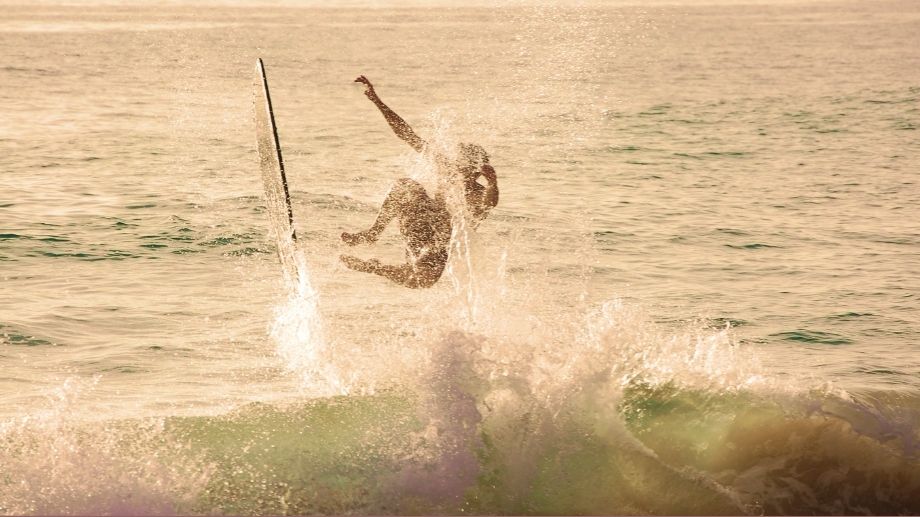
You also need to time the wave so you're reaching the wave slightly before it is about to break.
Too soon and the wave won't be breaking and you won't be able to catch it. Too late and the wave will break on you or have already broken and you won't be able to catch it.
Usually there is a 1-2 second window to reach the wave at the sweet spot and catch it.
Timing comes with practice so expect it to be difficult to time waves correctly at first. But with practice you'll get an intuitive sense of when to catch a wave.
Turning Onto The Wave

This again is a difficult skill that comes with practice.
They key tips I have for you here is to be leaning into the turn slightly before you actually reach the wave.
A taller steeper wave you'll need to do a faster, sharper turn whereas fatter and smaller waves you can do a slower more gradual turn. Different waves will give you shorter or longer rides and that just depends on your beach.
Another key tip when trying to turn onto a wave is to look where you want to go.
A big mistake I used to make is looking behind me so I could see the awesome spray from my turn, but this ruined every turn I tried to do. Ignore your spray and look towards where you want to go.
Your shoulders, body and eventually board will all follow where you are looking. So look where you want to go and throw your body into it.

